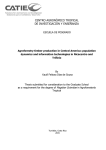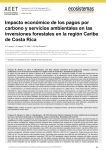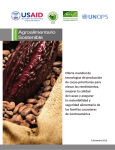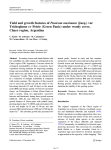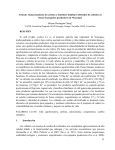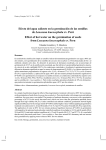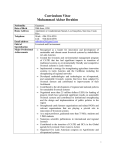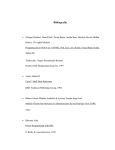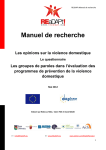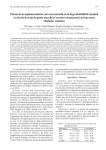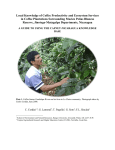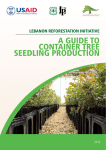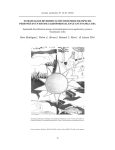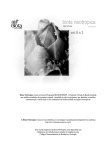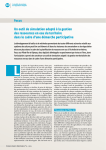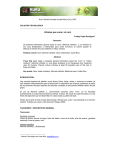Download Output file - Repositorio Institucional CATIE
Transcript
Article 1. Timber yields from smallholder agroforestry systems: a case study from two Central American territories ABSTRACT The importance of tropical timber for human activities is increasing, and developed countries are widely recognized for tropical timber production. However, the timber supply from tropical forests has been greatly impacted by increasing deforestation associated with complex and restrictive timber harvest laws. In Central America, as well as in other developing regions, reforestation programs have often been less successful than planned. In these cases, agroforestry presents a useful strategy to promote a tropical timber supply from smallholders, rural development and provisions of environmental services. We evaluated the effects of crop management on timber yields and potential revenues of timber sales in four types of agroforestry systems (silvopastoral, coffee, cocoa and live-fence) in Nicacentral (Nicaragua) and Honduran Trifinio (Honduras). The results suggest that smallholder timber production in agroforestry systems is a profitable activity, despite having lower market prices than timber from forests, due to the absence and lack of knowledge of silvicultural practices. The net present value from timber sales represents 11 to 49% of the total revenue of agroforestry systems. However, this amount could be 58% higher if farmers were to manage trees to achieve better tree quality. Encouraging the knowledge and adoption of silvicultural practice in agroforestry systems is an important endeavor to foster and increase timber sales from smallholder farmers in Central America. Keywords: timber yields, smallholders, agroforestry, Central America 1. Introduction Timber is a crucial worldwide forest resource (ITTO 2013) that provides energy and other benefits for developing and developed countries (FAO 2014). Tropical timber (hardwood) has special trade value due to its high mechanical resistance, varied colors, textures and applicability. However, deforestation from agricultural activities, the expansion of areas under forest protection and complex laws concerning timber harvesting have decreased the legal tropical timber supply, especially in Central America (Ibrahim and Camargo 2001; López and Detlefsen 2012; FAO 2013; ITTO 2013). Large-scale reforestation was expected to be a successful solution for issues with the timber supply and trade; however, recent history reveals that reforestation projects have often been less successful than planned and are responsible for generating several territorial conflicts (Bertomeu 2008; Snelder and Lasco 2008). Timber supply from smallholder agroforestry systems may be an alternative means to promote both timber production and sustainable land use; however this topic has received relatively little attention from policymakers in developing countries (Scheelje et al. 2011; FAO 2013). Diversity amongst agroforestry systems that creates high competition within an ecosystem may generate higher timber yields than homogeneous timber-forests. Many research projects that have focused on timber yields from smallholder agroforestry systems show the potential of tropical timber production (Somarriba et al. 2001a; Somarriba et al. 2001b; Viera and Pineda 2004; Borge 2009; Cruz et al. 2010; Chavarría et al. 2011; Somarriba and Beer 17 2011; Detlefsen and Somarriba 2012; Ibrahim and Zapata 2012; Jiménez 2012; Somarriba et al. 2014). In agroforestry systems, timber is one of the main sources of long-term income. Timber also represents a strategy for crisis prevention in the case of crop system failures, especially during droughts, pest incidences and market strikes (Camargo et al. 1999; Ibrahim and Pezo 2012; Somarriba et al. 2014). In coffee systems for example, income from timber yield is significant, ranging between 6 and 83% of total farm revenue, depending on the current market prices and quality of the wood (Jiménez 2012). In agroforestry pasturelands, the income generated by the sustainable use of trees can reach between 69 to 480 US$ ha-1 (Plata 2012). These revenues represent between 2.2 and 15% of the total net income of a silvopastoral system with dual purpose cattle production. In cocoa systems in Honduras, at 21 years of production, farmers may have a total income of approximately 65,026 US$ ha1 , with 85% of this income coming from timber production (Somarriba et al. 2012). Timber from agroforestry systems is a great economic option for farmers, considering it can provide higher revenues than traditional crop systems and can reduce costs of weeding and pest control of associated crops (Bertomeu 2006; Somarriba et al. 2012). Nevertheless, Central America lacks a market that values agroforestry products, especially timber, and the complex legal situation regarding timber may decrease farmer interest in participating in these types of production systems (Detlefsen et al. 2008; Cruz et al. 2010; Leiva 2011; Scheelje et al. 2011; Detlefsen and Scheelje 2012; Orozco 2012; Plata 2012; FAO 2013). Furthermore, incorrect species selection for each agroforestry system (Ibrahim and Zapata 2012; Salgado 2012) and lack of knowledge about tree growth and silvicultural management (Somarriba et al. 2001a; Santos-Martin et al. 2011) decreases the potential for higher timber yields and other market advantages from these systems. There is no doubt that tropical agroforestry systems may contribute to the global hardwood demand in a sustainable way. To change the paradigm of timber harvesting in the tropics, it is necessary to strengthen knowledge about potential timber yields and agroforestry management. This research aims to evaluate timber yields from agroforestry systems and financial contributions from the timber for smallholder farmers in coffee, cocoa, live-fence and silvopastoral agroforestry systems in Nicacentro (Nicaragua) and Trifinio (Honduras). 2. Methods 2.1. The study area This research was performed in Trifinio (15˚ 1’ N, 89˚ 8’ W), a boundary zone between Honduras, Guatemala and El Salvador; and in Nicacentro (13˚ 17’ N, 85˚ 42’ W), a strategic region in Nicaragua proposed by CATIE in 2008 under the Mesoamerican AgroEnvironmental Program (MAP). Both regions are included in the conceptual mark of the climate smart territories, where an effort exists to develop integrated strategies for ruralterritorial development. In both territories agriculture is the livelihood of the majority of the population. The Trifinio region has an area of 7,541 km², including 45 towns with a total of 670,000 inhabitants. The average annual precipitation is 1,600 mm, with an average annual temperature of 20 °C. The altitudinal range is between 600 and 1,600 m above sea level 18 (CTPT 2014). This research was conducted in three Honduran towns that form part of Trifinio: Copán Ruinas, Nueva Arcadia and Santa Rita. Nicacentro has an area of 6,500 km², including eight towns with a total of 360,000 inhabitants. The altitudinal range is between 350 and 1,750 m above sea level. The climate is classified as tropical wet with an average annual temperature of 26 °C and an annual precipitation between 1,600 and 2,400 mm (INEC 2006). The research for this study was conducted in El Cuá, a buffer area of the Bosawas Biosphere Reserve. 2.2. Data collection and analysis The permanent sample plots (PSP) were set up in 2010 in Nicacentro, and 2011 in Trifinio in agroforestry systems with different timber species including silvopastoral systems, coffee farms, cocoa farms and live-fences. Twenty seven PSPs were evaluated, including 10 circular plots with 0.5 ha in silvopastoral systems, rectangular plots with 0.1 ha in coffee (10 plots) and cocoa systems (3 plots), and 4 lineal plots with 100 m in live-fence systems. Tree inventory methodology was conducting the following recommendations from Detlefsen et al. (2012), who developed a protocol to measure trees in agroforestry systems. Diameter at breast height (DBH), commercial and total height, stem form, mortality and natural regeneration were evaluated in each PSP in 2010, 2011, 2012 and 2014 in Nicaragua; and in 2011, 2012 and 2014 in Trifinio. A smartphone-based data collection method was adopted in 2014 to assist in PSP measuring in both regions. To measure the population dynamics, three development stages were considered: (i) recruits (0.1 m ≥ height < 0.3 m) (ii) saplings (0.3 m ≥ height < 1.5 m, and DBH < 5.0 cm) (iii) trees (DBH ≥ 5.0 cm) Multiple measurements were taken to estimate periodical annual increments (PAI) of basal area and timber volume. Using InfoStat (Di Rienzo et al. 2014), correspondence analyses were performed to demonstrate the association of growth in basal area and timber volume between regions, systems and species. According to the ranges observed for PAI, the basal area increment (m² ha-1 year-1) was classified into groups: low (0.1 to 1.0), moderate (1.1 to 2.0) and high (≥ 2.1); and the timber volume yield (m³ ha-1 year-1) was classified into groups: low (0.1 to 3.0), moderate (3.1 to 6.0) and high (≥ 6.1). 2.3. Financial analysis A financial analysis was carried out to determine the cash flow in the farms. Crop yields (coffee, cocoa, milk), labor costs, total revenues per ha, net returns to labor, market timber prices and cost of tree management were derived from interviewing farmers as well as complementary information from Apaza (2011), Leiva (2011) and Toruño (2012). Using the average commercial volume of a harvesting tree (DBH ≥ 45 cm) and the local timber price of a board-foot (0.002360 m³) per species, the price of one tree per species was estimated. This methodology was used to get closer to the local reality, considering that trees are sold individually by their diameter class. The Net Present Value (NPV, using discount rates of 6% and 12%) and the Internal Rate of Return (IRR) were calculated and the potential revenues of timber harvest in the 19 agroforestry systems were determined. Timber harvesting and transportation costs were not included in the financial calculations because farmers in Nicaragua and Trifinio commonly sell timber as stump in the farms. Costs of land use were also not included. 2.4. Population dynamics model Usher model transition matrices were used for modeling the population dynamics where natural regeneration was observed. This model was widely used by Somarriba et al. (2001b), Súarez and Somarriba (2002), Borge (2009) and Somarriba et al. (2014) to calculate tree survival, growth and timber production for Cordia alliodora in cocoa-based agroforestry systems. Rates of recruitment, growth, harvest and mortality from the tree inventory in the PSPs were applied to this model. In this study, trees were sorted into 5-cm intervals of diameter class according to initial diameter, and average intervals by diameter class calculated. The minimum harvest diameter established was 45 cm for sawmilling wood and 35 cm for wood used as firewood. Growth time was calculated using the following equation: Equation 1 where Tij is the time it takes for one tree in diameter class i to transition to the next class j; Wi is the interval width of class i (cm); Ii is the mean annual diameter increment in class i (cm·year-1). The next procedure was to calculate the transition coefficient, using Equation 2 where Pi,j+1 is the coefficient of transition from period i to period j, represented in the percentage of individuals moving from one diameter class to the next class; Si is the tree survival rate in the diameter class. The coefficient of permanence was calculated with the following equation: Equation 3 where Qi, is the coefficient of permanence in the period i, represented by the percentage of individuals who remain in the diameter class. In the latter procedure the following matrix equation was applied: Equation 4 where nt+1 and n represent the diameter distribution (trees ha-1) between successive years t and t + 1. 3. Results and discussion 3.1. Timber species diversity Forty six species were identified and 66% of those species were classified as timber species. Pinus oocarpa, Tabebuia rosea, Swietenia macrophylla, Cordia alliodora and 20 Cedrela odorata represent 83% of the accumulated frequency of timber species (Fig. 2). Information about the frequency of these species is described by several authors for coffee, cocoa and pastureland systems in different regions of Latin America (Camargo et al. 1999; Ibrahim and Camargo 2001; Camargo et al. 2005; Esquivel-Mimenza et al. 2011; López and Detlefsen 2012; Salgado 2012; Somarriba et al. 2014). Others (10%) Quercus elliptica (1%) Terminalia amazonia (2%) Cedrela odorata (5%) Cordia alliodora (7%) Swietenia macrophylla (7%) Pinus oocarpa (51%) Tabebuia rosea (17%) Fig. 2. Accumulated abundance of timber species in cocoa, coffee, silvopastoral and live-fence agroforestry systems identified in Honduran Trifinio and Nicacentral. Except for C. odorata and S. macrophylla that were planted by the farmers, the other species found in the study (P. oocarpa, T. rosea and C. alliodora) came from natural regeneration. The management of natural regeneration may provide advantages for farmers, considering that it reduces investments on seedling production, nurseries and planting, as well as reduces the dependency on external seed sources and foreign technologies (Ibrahim and Zapata 2012). In addition, trees from natural regeneration may show higher resistance to microclimatic site conditions (Plath et al. 2011), which can contribute to their growth and yields. 3.2. Timber yields Table 1 presents the results of the PAIs of basal area and timber volume for each species, as well as the frequency, systems and countries where they occur. The results demonstrate an effect of the system on the PAIs of basal area and timber volume from Nicaragua and Honduras (Fig. 3 and Fig. 4). The practice of silvicultural management (pruning and thinning) was not identified in the populations and systems studied; the main reason is the lack of knowledge about trees requirements (Somarriba et al. 2001a; Santos-Martin et al. 2011). High rates of basal area growth and timber volume are related to silvopastoral systems and live-fences with P. oocarpa and C. odorata as the most frequent species, respectively, and are also related to higher increments. In an average population of 88 trees ha-1 dispersed in natural pastureland, P. oocarpa had a PAI of 12.84 m² ha-1 year-1 in timber volume. Relevant information for timber yields of P. taeda, a species of genus Pinus which has similar environmental requirements, was presented by USDA (2000) from silvopastoral systems and by Cubbage et al. (2012) from alley crop systems, which found an annual increment of 11.8 m³ ha-1 (100 trees ha-1) and 7.6 m³ ha-1 in the timber volumes, respectively. 21 Nevertheless, lower annual increments of timber volume (1.86 m³ ha-1) and stem quality were found in silvopastoral systems with 40 trees ha-1 of T. rosea. Trees dispersed in silvopastoral systems generally present low timber quality for sawmilling due to the absence of competition for light and the presence of some traits that restrict the growth in opened areas (Cruz et al. 2010; Ibrahim and Zapata 2012). Table 1. Periodical annual increment (PAI) of basal area and timber volume from different tree populations of agroforestry systems in Honduras and Nicaragua. Basal area growth is classified into: low (0.1 to 1.0), moderate (1.1 to 2.0) and high (≥ 2.1). Timber volume growth rate is classified into: low (0.1 to 3.0), moderate (3.1 to 6.0) and high (≥ 6.1). Species Cordia alliodora Cedrela odorata Pinus oocarpa Swietenia macrophylla Tabebuia rosea Country System F (trees ha-1) PAI Basal area (m² ha-1 year-1) PAI Timber volume (m³ ha-1 year-1) Honduras Nicaragua Nicaragua Nicaragua Nicaragua Honduras Honduras Nicaragua Nicaragua Nicaragua Honduras Nicaragua Nicaragua Honduras Nicaragua Coffee Cocoa Coffee Live-fence Silvopastoral Coffee Live-fence Cocoa Coffee Silvopastoral Silvopastoral Cocoa Coffee Live-fence Silvopastoral 52 40 60 24 14 80 44 50 210 8 88 20 140 8 40 1.61 0.63 0.86 0.10 0.08 2.16 1.55 0.40 1.09 0.06 2.87 0.35 1.38 0.06 0.27 4.50 2.70 4.20 1.00 0.54 7.30 11.12 2.00 8.90 0.48 12.84 1.90 17.40 0.12 1.86 Timber yields in live-fences with 44 trees ha-1 (110 trees km-1) of C. odorata and 8 trees ha-1 (20 trees km-1) of T. rosea showed a correlation with higher rates of PAI for C. odorata (11.12 m³ ha-1) and lower rates for T. rosea (0.12 m³ ha-1). Low increment rates for T. rosea in live-fences are due to the dominance of C. odorata, which has higher initial growth rates and suppresses growth of T. rosea. Even so, planting timber species in live-fences is a great strategy for smallholders. Viera and Pineda (2004), Bertomeu (2006), Borzone et al. (2007) and Beer (2012) reported significant results for growing timber species in homogenous live-fences. The authors demonstrate that timber yields in these systems are superior to trees in blocks due to the absence of lateral competition for light. 22 2.64 T. rosea Cocoa Axis 2 (21.26%) 1.80 Low Pastureland 0.96 C. alliodora Nicaragua Live-fence 0.12 C. odorata S. macrophylla P. oocarpa High Moderate Coffee -0.72 -1.07 -0.20 0.66 Honduras 1.53 2.39 Axis 1 (28.34%) PAI Basal Area ha-1 Species System Country year-1) Fig. 3. Basal area growth (m² from different tree populations of agroforestry systems in Honduras and Nicaragua. Biplot obtained by first two axis from a multiple correspondence analysis. Periodical annual increment (PAI) of basal area growth is classified into: low (0.1 to 1.0), moderate (1.1 to 2.0) and high (≥ 2.1). 2.90 T. rosea Axis 2 (20.98%) 1.97 Pastureland P. oocarpa Low 1.05 Cocoa C. alliodora 0.13 Live-fence Honduras Nicaragua Moderate S. macrophylla -0.80 -1.79 -0.76 C. odorata High Coffee 0.27 1.30 2.33 Axis 1 (22.05%) PAI Timber volume ha-1 Species System Country year-1) Fig. 4. Timber yields (m³ from different tree populations of agroforestry systems in Honduras and Nicaragua. Biplot obtained by first two axis from a multiple correspondence analysis. Periodical annual increment (PAI) of timber volume is classified into: low (0.1 to 3.0), moderate (3.1 to 6.0) and high (≥ 6.1). Coffee systems, as well as S. macrophylla, C. odorata and C. alliodora, the main species in these systems, are correlated with moderate and high increases of the PAIs of basal area and timber volume (Fig. 3 and Fig. 4). These farmers manage a high density of S. macrophylla (140 trees ha-1) and C. odorata (210 trees ha-1), and this is the reason for the high increments of timber volume (Table 1). High densities in the early years of the systems is a strategy to control vertical tree height growth, as well as avoid the growth of branches. However, to best take advantage of timber yields while not affecting coffee production, it 23 is necessary to reduce tree density by thinning (Haggar et al. 2001; Somarriba et al. 2001a; Salgado 2012), assuming the optimal level of shade in coffee systems is between 20-50%, depending on the environmental conditions and altitudinal ranges (Haggar et al. 2001; Virginio Filho et al. 2009). Results for timber yields of C. alliodora in cocoa systems contrasts with the data reported by Somarriba et al. (2014) in Central American cocoa systems. The authors reported an increment of 4.43 m³ ha-1 in an average population of 48 trees ha-1. Low increments in the cocoa systems may be associated with the age of the trees. In another study undertaken in cocoa systems of Central America, Somarriba et al. (2012) reported that trees present a fast growth rate until reaching 30-34 cm of DAP, followed by a period of slow growth. In our study, the average DAP of the trees in cocoa systems was 31 cm. It was observed that the absence of pruning of C. odorata in coffee systems results in irregular growth of trees and stimulates the formation of branches, damaging the quality of the wood. When comparing the growth of C. odorata between live-fence and coffee systems, the possibility is noted that even with higher growth of basal area in coffee systems (2.16 m² ha-1 in coffee versus 1.55 m² ha-1 in live-fences) the timber yields are lower due to malformation of the stem (7.30 m³ ha-1 in coffee versus 11.12 m³ ha-1 in live-fences). 3.3. Financial attractiveness of agroforestry timber production We estimate the timber price of a standing tree for sawmilling purchased at the farm, considering the stem quality of trees in the agroforestry systems evaluated in this study (Table 2). Table 2. Estimated timber price of a standing tree to sawmilling (DBH ≥ 45 cm) from agroforestry systems in Honduras and Nicaragua. The price of T. rosea represents the local price of a tree to firewood (DBH ≥ 35 cm). Average Board-foot price Timber price harvesting Tree price Species (US$) (US$ m-3) tree volume (US$ tree-1) (m³ tree-1) Pinus oocarpa 0.70 296.59 0.80 237.27 Cedrela odorata 0.95 402.52 0.90 360.25 Cordia alliodora 0.25 105.93 1.03 109.10 Swietenia macrophylla 1.75 741.48 1.23 912.01 Tabebuia rosea -3.85 1.30 5.01 We found that trees from agroforestry systems have lower values than trees from natural forests, both in the local and international market. Buyer’s reports illustrate that trees from agroforestry systems generally have irregular stem form and low timber quality. Furthermore, the absence of silvicultural management and the low quality of the seeds offered to farmers can be noted as reasons for the low quality of timber. Hoch et al. (2012) noted that the lack of financial support and the insufficient access to good planting material may be reasons for the uncertainty of timber quality of wood from agroforestry systems, as well as from other reforestation programs in the Amazon. In our case study, farmers could not tell if the quality of seeds supplied for their systems had been tested by laboratory trials. The combination of genetic, physical, physiologic and sanitary attributes determines seed quality and are essential to determine the success of tree growth and higher market value of trees (Popinigis 1983; FAO 1987; Lima Junior et al. 24 2005; Lima Junior 2010; Nyoka et al. 2014; Pritchard et al. 2014). Agroforestry systems have the advantage of offering short-term economic benefits through agricultural yields, while timber harvest benefits can be expected over medium to long time scales (Kent and Ammour 2012). Nevertheless, without appropriate resources and knowledge for tree management, the timber production in agroforestry systems may present less feasibility than expected by farmers. Table 3. Average annual costs, crop production and trees harvest in different agroforestry systems of Nicaragua and Honduras. Average Average annual cost of annual Number of trees System crop crop Unit Year harvested (ha) management production (US$ ha-1) (ha) 19 - C. alliodora 20 Coffee–Cedrela-Cordia 350.00 16.5 Quintal 18 - C. odorata 20 Coffee–Swietenia 350.00 15.5 Quintal 40 24 SSP–Pinus 500.00 10,500 L 20 each 10 SSP–Tabebuia 475.00 9,000 L 5 each 6 Cocoa–Cordia 192.00 7 Quintal 11 20 -- -- -- 31 20 Live-Fence–Cedrela However, assuming two scenarios of discount rates to calculate the NPV (6% and 12%) of crop and timber revenues shows that agroforestry systems are still profitable to smallholders. The NPV from timber revenues in a scenario of 6% of the discount rate are more pronounced, mainly in coffee and cocoa systems (Fig. 5). Fig. 5. Net present value by revenues (NPV) from crop production and timber sales, and Internal rate for return (IRR) for different agroforestry systems in Nicaragua and Honduras considering two scenarios of discount rate of NPV (6% and 12%) over twenty-four years. Silvopastoral systems with P. oocarpa need no intensive silvicultural management and have the best IRR and NPV of timber sales in both scenarios. In Nicaragua, trees on silvopastoral systems with T. rosea are managed for firewood production and are less profitable from an economic perspective (a tree with an average volume of 1.3 m³ is sold by US$ 5 in the local market). We developed harvesting plans according to the population dynamics of both species; farmers can harvest 20 trees ha-1 of P. oocarpa every 10 years, and 5 trees ha-1 of T. rosea every 6 years. Results of population dynamics are explained in 25 the next section. According to our estimation, net revenues from timber sales in silvopastoral systems with P. oocarpa under this harvesting plan are 64% superior (an increment of US$ 4,800 ha-1; Fig. 6) in the years of timber harvest (each 10 years). However, financial contributions from timber sales of T. rosea in silvopastoral systems are less (only 2% of total net revenues in the years of timber harvest), due to the population dynamics and the strategy of timber sale observed. It is important to highlight that despite having lower NPV than others systems, live-fences are an alternative to take advantage of important financial returns from underutilized areas of farms (Beer et al. 2009), and low NPV does not indicate an unprofitable activity. In our study, live-fences of C. odorata yield US$ 483 year-1, with a total income of US$ 9,660 at the 20 year mark, where trees are sold at 31 trees ha-1. Trees in live-fences also provide aesthetic benefits to farms (Beer 2000), ecological connectivity and conservation of biodiversity (Harvey et al. 2005; Chacón and Harvey 2006; Pulido-Santacruz and Renjifo 2011; Harvey 2013), wind protection and disease and erosion control (Cleugh 1998; Faustino 2000; Peri and Bloomberg 2002). Fig. 6. Cash flow (US$ ha-1) from crop production and timber sales in different agroforestry systems in Nicaragua and Honduras over twenty-four years. Agroforestry systems with coffee and S. macrophylla demonstrate important revenues and, according to our estimation, have the second highest NPV from timber revenues in both scenarios of discount rates (Fig. 5). However, NPV for revenues of timber sales could be 58% higher than current values if the trees on coffee-Swietenia agroforestry system had been managed to acquire higher market prices (assuming that a standing tree of S. macrophylla with high stem quality can be sold for US$ 1,300). Even receiving less income from timber sales, due to the low quality of stem, the estimated cash flows of the studied systems show that the timber sales are responsible for important revenue increases for smallholder farmers (Fig. 6). 26 3.4. Population dynamics We found an expressive incidence of natural regeneration in silvopastoral systems with natural grass that include silvopastoral systems with P. oocarpa and T. rosea. The effects of pastureland management on tree cover and natural regeneration occurrence were presented by some researchers in Latin America (Simón et al. 1998; Ibrahim and Camargo 2001; Camargo et al. 2005; Esquivel et al. 2008; Esquivel-Mimenza et al. 2011; Harvey et al. 2011). In our study, the frequency of seedlings was 74% superior in silvopastoral pastureland with natural grass as opposed to pasturelands with brizantha grass (Brachiaria brizantha). The frequency of seedlings and saplings were also 52% and 31% superior, respectively, in pasturelands with natural grass. Natural regeneration of C. alliodora in cocoa systems is seen, as well as other species in coffee and live-fence systems. According to interviews with farmers, the main reason for the absence of natural regeneration in these systems are the agricultural practices used for weed control by farmers. The same information was reported by some authors in Central America (Camargo et al. 1999; Ibrahim and Camargo 2001; Esquivel et al. 2008). A strategy to promote the sustainability (timber harvest and trees benefits) of these systems without compromising the crop production and management is to encourage the collection of seeds from the trees and the creation of nurseries in the farms. Nurseries in coffee and cocoa systems have been a common practice over the years, when replacing coffee/cocoa trees is necessary (during the field research we observed farmers managing nurseries of coffee trees). With these nurseries, farmers could produce seedlings from the timber trees associated with coffee seedlings. Table 4. Growth, survival and transitions coefficients for a population of Pinus oocarpa and Tabebuia rosea with natural regeneration in pasturelands. R: recruits, S: sapling, P: individuals that move to next diameter class, Q: individuals that stay in the same diameter class. Transition Diameter upper Grow rate Annual coefficients Species class limit (cm) (cm year-1) survival P Q Pinus oocarpa Tabebuia rosea R S 10 15 20 25 30 35 40 R S 10 15 20 25 0.50 2.50 0.78 1.38 1.32 1.16 0.86 0.98 0.98 0.50 2.28 1.68 1.58 1.44 1.34 0.90 0.50 0.90 0.95 0.95 0.95 0.95 0.95 0.95 0.05 0.60 0.60 0.95 0.95 0.98 0.45 0.25 0.14 0.26 0.25 0.22 0.16 0.19 0.19 0.03 0.27 0.2 0.3 0.27 0.15 0.45 0.25 0.76 0.69 0.7 0.73 0.79 0.76 0.76 0.03 0.33 0.4 0.65 0.68 0.7 We developed the population dynamic projection associated with timber harvest plans for silvopastoral systems with P. oocarpa and T. rosea where the natural regeneration was expressive. Timber harvest of these species can be done sustainably by using proper management of the natural regeneration. Table 4 presents the growth rate and transition coefficients of both species. 27 N (trees ha-1) 30 25 20 nt 15 nt+1 10 nt+11 5 nt+12 0 R S 10 15 20 25 30 35 40 H Diameter upper class limit (cm) Fig. 7. Simulation of population dynamic of Pinus oocarpa with natural regeneration in pasturelands of Honduras with an average tree population of 88 trees ha-1 and 30 seedlings ha-1 and a timber harvesting cycle of 20 trees ha-1 each 10 years. R: recruits, S: sapling, H: harvest. N (trees ha-1) Assuming the current average population of trees in silvopastoral systems of P. oocarpa (88 trees ha-1) and the growth rates that we found within these systems, 20 trees ha-1 (DBH ≥ 45 cm) can be harvested every 10 years (Fig. 7). The minimal conditions needed to guarantee the success of the harvest plan are the maintenance of 30 trees ha-1 year-1 (currently farmers manage that quantity of seedlings), the minimum annual survival rate for each diameter class (Table 4) and seed-production trees. It is important to highlight that silvopastoral systems of P. oocarpa are changing the population dynamics by the dominance of seedlings of Quercus elliptica, which have a biological interaction with squirrels (Sciuridae) that eat the seeds of P. oocarpa and disperse the seeds of Q. elliptica (the frequency of Q. elliptica seedlings was twice than seedlings of P. oocarpa). Studying this interaction is key to ensure the sustainability of timber harvest of P. oocarpa. 45 40 35 30 25 20 15 10 5 0 nt nt+1 nt+6 nt+7 R S 10 15 20 25 H Diameter upper class limit (cm) Fig. 8. Simulation of population dynamics and timber harvesting cycle of Tabebuia rosea with natural regeneration in pasturelands of Nicaragua with an average tree population of 40 trees ha -1 and 40 seedlings ha1 and a timber harvesting cycle of 5 trees ha-1 each 6 years. R: recruits, S: sapling, H: harvest. The population dynamics model for T. rosea indicates that to maintain the sustainability of the system, farmers can only harvest 5 trees ha-1 every 6 years (Fig. 8). According to our model, the sale of T. rosea trees for firewood is an unfeasible activity, increasing only 1% on the NPV of the system’s revenues. The main reason is the low growth rate of the species and the low prices found in the local market. Adoption of another market strategy (sale to sawmilling) could improve revenue of timber sales in these systems. We recommend the 28 transplantation of dispersal seedlings of T. rosea to high-density homogenous live-fences (considering that this species were suppressed when associated with another species) to promote the apical growth, improve the stem quality for sawmilling and avoid stem furcation (Beer 2000). 4. Conclusions This study demonstrates the effects of agroforestry system management on timber yields and farm revenues. The most expressive timber yields, NPV and IRR were observed in silvopastoral systems with P. oocarpa, coffee systems with C. odorata and C. alliodora, coffee systems with S. macrophylla and live-fences of C. odorata. In all systems, the practice of silvicultural management (formative pruning and thinning) by farmers was not observed. Absence of silvicultural management, as well as low seed quality resulted in low sale values of the trees. In coffee systems with S. macrophylla, for example, the price of trees could be 58% higher than the current price if trees were managed. Even so, the analysis of NPV and IRR in these systems indicate that sales of timber is a profitable activity for smallholders. Timber (for sawmilling) revenues represent 11-49% of the NPV of agroforestry systems depending on the type of system, species and discount rate. Furthermore, we observed that the natural regeneration of the studied timber species was expressively presented for P. oocarpa and T. rosea in silvopastoral systems with natural grass. Coffee, cocoa and live-fence systems showed an inexpressive or absent presence of natural regeneration due to the agricultural practices in crop management and weed control. A strategy to maintain tree benefits and timber revenues without compromising the crop production is the seed collection from trees in the systems and seedling production in nurseries. In coffee systems, the seedling production could be associated with the production of coffee seedlings on farms. We recommend the transplantation of dispersal seedlings of T. rosea to live-fences to promote the apical growth and improve the stem quality for sawmilling. Fostering knowledge about silvicultural management and access to quality seeds are essential to improve the revenues from timer sales in smallholder’s agroforestry systems. Acknowledgments We would like to thank the farmers and field technicians for their contributions in the establishment of the Permanent Sample Plots and data collection. This research received financial support from Project Finnfor (CATIE, Costa Rica), The Ministry for Foreign Affairs of Finland and Natura Inovação e Tecnologia de Produtos (Brazil). Thanks to Lindsey Hethcote for the English editing. References Apaza, A. 2011. Potencialidades socio-económicas de la producción, procesamiento y mercadeo de productos maderables provenientes de sistemas silvopastoriles en Copán, Honduras. M.Sc. Thesis. Turrialba, Costa Rica, Centro Agronómico Tropical de Investigación y Enseñanza. 155 p. Beer, J. 2000. Linderos maderables. In Méndez, E.; Beer, J.; Faustino, J.; Otarola, A. eds. 2000. Plántación de árboles en línea. Turrialba, Costa Rica, CATIE. p. 69-80. (Materiales de enseñanza). 29 Beer, J.; Ibrahim, M.; Somarriba, E.; Barrance, A.; Leakey, R. 2009. Establecimiento y manejo de árboles en sistemas agroforestales. 198-242 p. (Árboles de Centroamérica) (1). Beer, J. 2012. Producción de árboles maderables en linderos. In Detlefsen, G.; Somarriba, E. eds. 2012. Producción de madera en sistemas agroforestales de Centroamérica. Turrialba, Costa Rica, CATIE. p. 199-210. (Technical Series). Available in: http://finnfor.catie.ac.cr/admin/documents/208 Bertomeu, M. 2006. Financial evaluation of smallholder timber-based agroforestry systems in Claveria, Northern Mindanao, the Philippines. Small-scale Forestry 5(1): 57-81 doi: 10.1007/s11842-006-0004-6 ________. 2008. Can Smallholder Tree Farmers Help Revive the Timber Industry in Deforested Tropical Countries? A Case Study from Southern Philippines. In Snelder, D.; Lasco, R. eds. 2008. Smallholder Tree Growing for Rural Development and Environmental Services. Springer Netherlands. p. 177-191. (Advances in Agroforestry). doi: 10.1007/978-1-4020-8261-0_8 Borge, W.A.C. 2009. Producción de madera y carbono en la regeneración de sistemas agroforestales en la reserva indígena de Talamanca, Costa Rica. Ciencia e Interculturalidad 2(2): 108-130 Available in: http://revistas.uraccan.edu.ni/index.php/Interculturalidad/article/view/148 Borzone, H.A.; Bardi, J.F.; Laddaga., J.E. 2007. Crecimiento de Eucalyptus camaldulensis Dehnh cultivado como cortina en un establecimiento agropecuario del Partido de Azul (Pcia. de Bs. As.). Quebracho 1(14): 65-73 Available in: http://www.scielo.org.ar/scielo.php?pid=S1851-30262007000100008&script=sci_arttext Camargo, J.C.; Ibrahim, M.; Somarriba, E.; Finegan, B.; Current, D. 1999. Factores ecológicos y socioeconómicos que influyen en la regeneración natural del laurel (Cordia alliodora) en sistemas silvopastoriles del trópico húmedo y subhúmedo de Costa Rica. Agroforestería en las Américas 7(26): 46-52 Available in: www.fao.org/wairdocs/lead/x6336s/X6336S00.htm#RESUMEN Camargo, J.C.; Feijoo, A.; Zúñiga, M.C.; Cardona, H.; Gaviria, J. 2005. Silvopastoral systems with isolated timber trees within pastures in the Coffee region of Colombia. Livestock Research for Rural Development 17(5): Available in: www.lrrd.org/lrrd17/5/cama17051.htm Chacón, M.; Harvey, C.A. 2006. Live fences and landscape connectivity in a neotropical agricultural landscape. Agroforestry Systems 68(1): 15-26 doi: 10.1007/s10457-0055831-5 Chavarría, A.; Detlefsen, G.; Ibrahim, M.; Galloway, G.; Camino, R.d. 2011. Análisis de la productividad y la contribución financiera del componente arbóreo en pequeñas y medianas fincas ganaderas de la subcuenca del río Copán, Honduras. Agroforestería en las Américas 48(1): 146-156 Cleugh, H.A. 1998. Effects of windbreaks on airflow, microclimates and crop yields. Agroforestry Systems 41(1): 55-84 doi: 10.1023/A:1006019805109 Cruz, A.R.; Detlefsen, G.; Ibrahim, M.; Camino, R.d.; Galloway, G. 2010. Aprovechamiento del recurso maderable en sistemas silvopastoriles de Belice. Recursos Naturales y Ambiente 59(60): 91-98 Available in: http://finnfor.catie.ac.cr/admin/documents/27 CTPT (Comisión Trinacional del Plan Trifinio, El Salvador). 2014. Región del Trifinio en breve. Comisión Trinacional del Plan Trifinio. San Salvador, El Salvador. Available in: http://www.sica.int/trifinio/trifinio/breve_trifinio.aspx?IdEnt=140 Cubbage, F.; Glenn, V.; Paul Mueller, J.; Robison, D.; Myers, R.; Luginbuhl, J.-M.; Myers, R. 2012. Early tree growth, crop yields and estimated returns for an agroforestry trial in Goldsboro, North Carolina. Agroforestry Systems 86(3): 323-334 doi: 10.1007/s10457012-9481-0 Detlefsen, G.; Pomareda, C.; Ibrahim, M.; Pezo, D. 2008. La legislación forestal debe ser revisada para fomentar y aprovechar el recurso maderable en fincas ganaderas de 30 Centroamérica. Turrialba, Costa Rica, CATIE. 34 p. (Síntesis para Decisores) Available in: http://orton.catie.ac.cr/repdoc/A2445E/A2445E.PDF Detlefsen, G.; Marmillod, D.; Scheelje, M.; Ibrahim, M. 2012. Protocolo para la instalación de parcelas permanentes de medición de la producción maderable en sistemas agroforestales de Centroamérica. Turrialba, Costa Rica, CATIE. 19 p. (Manual técnico no. 107) doi: 978-9977-57-574-2 Available in: http://finnfor.catie.ac.cr/admin/documents/184 Detlefsen, G.; Scheelje, M. 2012. Las normativas legales y el aprovechamiento de la madera en fincas. In Detlefsen, G.; Somarriba, E. eds. 2012. Producción de madera en sistemas agroforestales de Centroamérica. Turrialba, Costa Rica, CATIE. p. 211-244. (Technical Series). Available in: http://finnfor.catie.ac.cr/admin/documents/208 Detlefsen, G.; Somarriba, E. 2012. Producción de madera en sistemas agroforestales de Centroamérica. 1 ed. Detlefsen, G.; Somarriba, E. eds. Turrialba, Costa Rica, CATIE. 244 p. (Manual técnico no. 109) Di Rienzo, J.A.; Casanoves, F.; Balzarini, M.G.; Gonzalez, L.; Tablada, M.; Robledo, C.W. 2014. InfoStat. versión 24-03-2011 ed. Córdoba, Argentina, Universidad Nacional de Córdoba. Available in: http://www.infostat.com.ar/ Esquivel-Mimenza, H.; Ibrahimb, M.; Harvey, C.A.; Benjamin, T.; Sinclair, F.L. 2011. Dispersed trees in pasturelands of cattle farms in a tropical dry ecosystem. Tropical and Subtropical Agroecosystems 14(2011): 933-941 Available in: http://www.scielo.org.mx/pdf/tsa/v14n3/v14n3a6.pdf Esquivel, M.J.; Harvey, C.A.; Finegan, B.; Casanoves, F.; Skarpe, C. 2008. Effects of pasture management on the natural regeneration of neotropical trees. Journal of Applied Ecology 45(1): 371-380 doi: 10.1111/j.1365-2664.2007.01411.x FAO (Food and Agriculture Organization of The United Nations, Italy). 1987. A guide to forest seed handling with special reference to the tropics. Willan, R.L. ed. Rome, Italy, FAO. (FAO Forestry Paper) (2). Available in: http://www.fao.org/docrep/006/ad232e/ad232e00.htm ________. 2013. Advancing Agroforestry on the Policy Agenda: A guide for decisionmakers. Place, F.; Gauthier, M. eds. Rome, Italy, Food and Agriculture Organization of The United Nations. 49 p. (Agroforestry Working Paper) (1). Available in: http://www.fao.org/docrep/017/i3182e/i3182e00.pdf ________. 2014. State of the World's Forests: Enhancing the socioeconomic benefits from forests. Rome, Italy, Food and Agriculture Organization of The United Nations. 145 p. (State of the World's Forests) doi: 978-92-5-308270-4 Available in: http://www.fao.org/3/a-i3710e.pdf Faustino, J. 2000. Cortinas rompevientos. In Méndez, E.; Beer, J.; Faustino, J.; Otarola, A. eds. 2000. Plántación de árboles en línea. Turrialba, Costa Rica, CATIE. p. 23-41. (Materiales de enseñanza). Haggar, J.P.; Schibli, C.; Staver, C. 2001. ¿Cómo manejar árboles de sombra en cafetales? Agroforestería en las Américas 8(29): 37-41 Harvey, C.A.; Villanueva, C.; Villacís, J.; Chacón, M.; Muñoz, D.; López, M.; Ibrahim, M.; Gómez, R.; Taylor, R.; Martinez, J.; Navas, A.; Saenz, J.; Sánchez, D.; Medina, A.; Vilchez, S.; Hernández, B.; Perez, A.; Ruiz, F.; López, F.; Lang, I.; Sinclair, F.L. 2005. Contribution of live fences to the ecological integrity of agricultural landscapes. Agriculture, Ecosystems & Environment 111(1–4): 200-230 doi: 10.1016/j.agee.2005.06.011 Harvey, C.A.; Villanueva, C.; Esquivel, H.; Gómez, R.; Ibrahim, M.; Lopez, M.; Martinez, J.; Muñoz, D.; Restrepo, C.; Saénz, J.C.; Villacís, J.; Sinclair, F.L. 2011. Conservation value of dispersed tree cover threatened by pasture management. Forest Ecology and Management 261(10): 1664-1674 doi: 10.1016/j.foreco.2010.11.004 Harvey, C.A.T., N. I. J.; Estrada, A. 2013. Live fences, isolated trees, and windbreaks: tools for conserving biodiversity in fragmented tropical landscapes. In Götz Schroth, G.A.B.d.F., Celia A. Harvey, Claude Gascon, Heraldo L. Vasconcelos, Anne-Marie N. Izac. 31 ed. 2013. Agroforestry and biodiversity conservation in tropical landscapes. Washington, D.C., USA, Island Press. p. 261-289. Hoch, L.; Pokorny, B.; de Jong, W. 2012. Financial attractiveness of smallholder tree plantations in the Amazon: bridging external expectations and local realities. Agroforestry Systems 84(3): 361-375 doi: 10.1007/s10457-012-9480-1 Ibrahim, M.; Camargo, J.C. 2001. ¿Cómo aumentar la regeneración de árboles maderables en potreros? Agroforestería en las Américas 8(32): 35-45 Available in: ftp://ftp.fao.org/docrep/nonfao/lead/x6354s/x6354s00.pdf Ibrahim, M.; Pezo, D. 2012. Interacciones en sistemas silvopastoriles. In Detlefsen, G.; Somarriba, E. eds. 2012. Producción de madera en sistemas agroforestales de Centroamérica. Turrialba, Costa Rica, CATIE. p. 69-90. (Technical Series). Available in: http://finnfor.catie.ac.cr/admin/documents/208 Ibrahim, M.; Zapata, P. 2012. Producción de madera en sistemas silvopastoriles. In Detlefsen, G.; Somarriba, E. eds. 2012. Producción de madera en sistemas agroforestales de Centroamérica. Turrialba, Costa Rica, CATIE. p. 112-132. (Technical Series). Available in: http://finnfor.catie.ac.cr/admin/documents/208 INEC (Instituto Nacional de Estadísticas y Censos, Nicaragua). 2006. Censo de población y de vivienda 2005. Manágua, Nicaragua, INEC. 40 p. (Censos Nacionales) (7). ITTO (International Tropical Timber Organization, Japan). 2013. Annual review and assessment of the world timber situation, 2012. Yokohama, Japan, International Tropical Timber Organization (ITTO). 182 p. (Annual report ) Available in: http://www.itto.int/annual_review/ Jiménez, N.G. 2012. Producción de madera y almacenamiento de carbono en cafetales con cedro (Cedrela odorata) y caoba (Swietenia macrophylla) en Honduras. M.Sc. Thesis. Turrialba, Costa Rica, CATIE. 121 p. Kent, J.; Ammour, T. 2012. Análisis financiero y económico de la producción de madera en sistemas agroforestales. In Detlefsen, G.; Somarriba, E. eds. 2012. Producción de madera en sistemas agroforestales de Centroamérica. Turrialba, Costa Rica, CATIE. p. 91-111. (Technical Series). Available in: http://finnfor.catie.ac.cr/admin/documents/208 Leiva, E.R. 2011. Efectos del marco político y legislativo en el aprovechamiento de la madera de sistemas agroforestales del Municipio de El Cuá, Nicaragua. M.Sc. Thesis. Turrialba, Costa Rica, Centro Agronómico Tropical de Investigación y Enseñanza. 177 p. Lima Junior, M.J.V.; Ellis, R.H.; Hong, T.D.; Ferraz, I.D.K. 2005. Drying method influences the development of germinability, dessication tolerance and subsequent longevity of immature seeds of sumaúma. Seed Science and Technology 33(1): 147-156 Lima Junior, M.J.V. 2010. Manual de procedimentos para análise de sementes florestais. Lima Junior, M.J.V. ed. Londrina, Brazil, Associação Brasileira de Tecnologia de Sementes - ABRATES. 83 p. López, A.; Detlefsen, G. 2012. Agroforestería y la producción de madera. In Detlefsen, G.; Somarriba, E. eds. 2012. Producción de madera en sistemas agroforestales de Centroamérica. Turrialba, Costa Rica, CATIE. p. 9-20. (Technical Series). Available in: http://finnfor.catie.ac.cr/admin/documents/208 Nyoka, B.; Roshetko, J.; Jamnadass, R.; Muriuki, J.; Kalinganire, A.; Lillesø, J.-P.; Beedy, T.; Cornelius, J. 2014. Tree Seed and Seedling Supply Systems: A Review of the Asia, Africa and Latin America Models. Small-scale Forestry: 1-21 doi: 10.1007/s11842-0149280-8 Orozco, L. 2012. Instrumentos y política forestal de Nicaragua: Implicaciones para el fomento de los sistemas silvopastoriles. Turrialba, Costa Rica, CATIE. 2 p. (Policy Brief) Available in: http://finnfor.catie.ac.cr/admin/documents/197 Peri, P.L.; Bloomberg, M. 2002. Windbreaks in southern Patagonia,Argentina: A review of research on growth models, windspeed reduction, and effects oncrops. Agroforestry Systems 56(2): 129-144 doi: 10.1023/A:1021314927209 Plata, O.F. 2012. Análisis ex ante del aprovechamiento maderable de árboles en potrero, con implementación de prácticas silviculturales, en sistemas silvopastoriles en Esparza, 32 Costa Rica. M.Sc. Thesis. Turrilba, Costa Rica, Centro Agronómico Tropical de Investigación y Enseñanza. 123 p. Plath, M.; Mody, K.; Potvin, C.; Dorn, S. 2011. Do multipurpose companion trees affect high value timber trees in a silvopastoral plantation system? Agroforestry Systems 81(1): 7992 doi: 10.1007/s10457-010-9308-9 Popinigis, F. 1983. A germinação das sementes. 2 ed. Brasilia, Brazil, Pax - Gráfica e Fotolito Ltda. 289 p. Pritchard, H.W.; Moat, J.F.; Ferraz, J.B.S.; Marks, T.R.; Camargo, J.L.C.; Nadarajan, J.; Ferraz, I.D.K. 2014. Innovative approaches to the preservation of forest trees. Forest Ecology and Management 1: 1-11 doi: 10.1016/j.foreco.2014.08.012 Pulido-Santacruz, P.; Renjifo, L. 2011. Live fences as tools for biodiversity conservation: a study case with birds and plants. Agroforestry Systems 81(1): 15-30 doi: 10.1007/s10457-010-9331-x Salgado, J. 2012. Producción de madera en sistemas agroforestales con café. In Detlefsen, G.; Somarriba, E. eds. 2012. Producción de madera en sistemas agroforestales de Centroamérica. Turrialba, Costa Rica, CATIE. p. 145-160. (Technical Series). Available in: http://finnfor.catie.ac.cr/admin/documents/208 Santos-Martin, F.; Bertomeu, M.; van Noordwijk, M.; Navarro, R. 2011. Why smallholders plant native timber trees: lessons from the Philippines. Bogor, Indonesia, ASB Partnership and ICRAF. 4 p. (Policy Brief) Available in: http://outputs.worldagroforestry.org/record/6570/files/ICRAF-2014-414.pdf Scheelje, M.; Detlefsen, G.; Ibrahim, M.; Chavarría, A. 2011. Honduras: la simplificación de trámites para el manejo y comercialización de árboles maderables en fincas ganaderas puede estimular la incorporación y manejo de árboles en forma sustentable por parte de pequeños productores. Turrialba, Costa Rica, CATIE. 2 p. (Policy Brief) Available in: http://finnfor.catie.ac.cr/admin/documents/45 Simón, M.; Ibrahim, M.; Finegan, B.; Pezo, D. 1998. Efectos del pastoreo bovino sobre la regeneración de tres especies arbóreas comerciales del chaco argentino: un método de protección. Available in: ftp://ftp.fao.org/docrep/nonfao/lead/X6322S/X6322S00.pdf Snelder, D.J.; Lasco, R.D. 2008. Smallholder Tree Growing in South and Southeast Asia. In Snelder, D.; Lasco, R. eds. 2008. Smallholder Tree Growing for Rural Development and Environmental Services. Springer Netherlands. p. 3-33. (Advances in Agroforestry). doi: 10.1007/978-1-4020-8261-0_1 Somarriba, E.; Beer, J.; Muschler, R.G. 2001a. Research methods for multistrata agroforestry systems with coffee and cacao: recommendations from two decades of research at CATIE. Agroforestry Systems (53): 195–203 doi: 10.1023/A:1013380605176 Somarriba, E.; Valdivieso, R.; Vásquez, W.; Galloway, G. 2001b. Survival, growth, timber productivity and site index of Cordia alliodora in forestry and agroforestry systems. Agroforestry Systems 51: 111-118 doi: 10.1023/A:1010699019745 Somarriba, E.; Beer, J. 2011. Productivity of Theobroma cacao agroforestry systems with timber or legume service shade trees. Agroforestry Systems 81(2): 109-121 doi: 10.1007/s10457-010-9364-1 Somarriba, E.; Orozco, L.; López, A. 2012. Producción de madera en sistemas agroforestales con cacao. In Detlefsen, G.; Somarriba, E. eds. 2012. Producción de madera en sistemas agroforestales de Centroamérica. Turrialba, Costa Rica, CATIE. p. 133-144. (Technical Series). Available in: http://finnfor.catie.ac.cr/admin/documents/208 Somarriba, E.; Suárez-Islas, A.; Calero-Borge, W.; Villota, A.; Castillo, C.; Vílchez, S.; Deheuvels, O.; Cerda, R. 2014. Cocoa-timber agroforestry systems: Theobroma cacaoCordia alliodora in Central America. Agroforest Systems 88(1): doi: 10.1007/s10457014-9692-7 Súarez, A.; Somarriba, E. 2002. Aprovechamiento sostenible de madera de Cordia alliodora de regeneración natural en cacaotales y bananales de indígenas de Talamanca, Costa Rica. Agroforestería en las Américas 9(35-36): 50-54 33 Toruño, I. 2012. Análisis financiero-económico de fincas con varias actividades productivas y el rol de la familia en la producción y toma de decisiones en el Centro Norte de Nicaragua. M.Sc. Thesis. Turrialba, Costa Rica, Centro Agronómico Tropical de Investigación y Enseñanza. 157 p. USDA (United States Department of Agriculture, USA). 2000. From pine forest to a silvopasture system. United States of America, USDA. 4 p. (Agroforestry Notes) (18). Viera, C.J.; Pineda, A. 2004. Productividad de lindero maderable de Cedrela odorata. Agronomía mesoamericana 15(1): 85-92 Available in: http://teca.fao.org/es/read/3712 Virginio Filho, E.M.; Barrios, M.; Morales, I.T. 2009. ¿Cómo podemos mejorar la finca cafetalera en la cuenca? Managua, Nicaragua, CATIE. 71 p. (Capacitación agricola guías) (1). 34


















